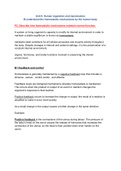Essay
Unit 9: Human Regulation and Reproduction - Learning aim B
- Course
- Institution
Pearson BTEC Level 3 National Extended Diploma in Applied Science Unit 9: Human Regulation and Reproduction Learning aim B: Understand the homeostatic mechanisms used by the human body Processes, organs and hormones involved in maintaining the internal environment. Contains: D2: Analyse the...
[Show more]



